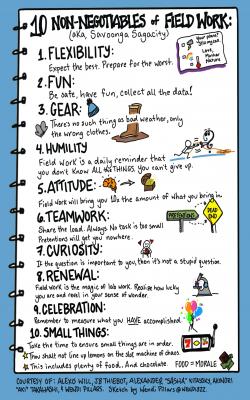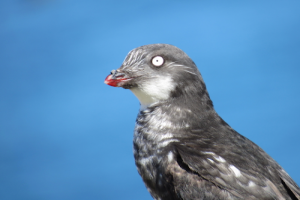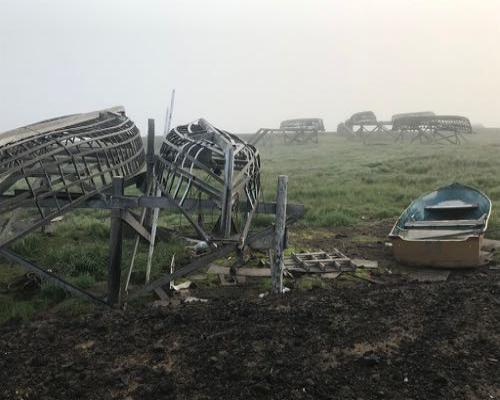What is PolarTREC?
PolarTREC (Teachers and Researchers Exploring and Collaborating) is a program in which formal and informal educators spend 3-6 weeks participating in hands-on field research experiences in the polar regions. The goal of PolarTREC is to invigorate polar science education and understanding by bringing educators and polar researchers together.
Summary of Science
The primary objectives of this particular research project are twofold: 1) track the winter migration of seabirds using loggers and 2) measure both their response to late summer and late winter environmental conditions through blood, feathers, and reproductive performance. Savoonga, Alaska (St. Lawrence Island) is a haven for many seabirds and has been home to this research for three years (summers of 2016-2018).
 I often resort to sketching new information to help me remember and make sense of dates and details, and to simplify complexity.
I often resort to sketching new information to help me remember and make sense of dates and details, and to simplify complexity.
Overall, the larger goal of the three year research has been to determine how these Arctic seabirds are interacting with sea ice and the multilayered cause and effect of oceanic conditions, particularly food availability and quality. In 2018 there was historic low winter sea ice; it was present for the shortest amount of time on record and disappeared from the Bering Strait earlier than ever before. Shore ice on St. Lawrence Island never developed, exposing coastlines to erosion and hampering people’s access to winter hunting areas. On the other hand, no sea ice provides "good research conditions" because years with contrasting ocean conditions in such a short study period can be ideal for sussing out the role of sea ice in the seabirds’ annual cycle.
Expectations and Outcomes
1. Expectation: I expected to start working in field conditions right away based on our pre-field calls and emails.
Reality: There was no time wasted: I went into the field the morning directly after an evening arrival.
 A trio of curious crested auklets monitors our monitoring at the Kitnik site.
A trio of curious crested auklets monitors our monitoring at the Kitnik site.
Field conditions, full days outside, and keeping intensely busy were the norm. I realized just how much I enjoyed being outside, and what a different kind of satisfaction there is to a day of focused physical work as part of a tightly knit team. Trust develops quickly.
2. Expectation: I wanted to do “real research” and understand the processes behind data collection, especially with birds, because this was totally new territory for me.
Reality: I learned that real research is intense, on-the-ground gritwork. The saying that “time is money” is very true, hence the 7 days a week work schedule. Mission truly drives the schedule, although the animals don’t necessarily agree to the study mission or cooperate with any particular schedule. I also realized just how physical the work could be, rappelling down cliff-sides, climbing over rocks, walking across very uneven alternately rocky and quaggy tundra, battling the elements, and four-wheeling to our worksites--a journey where neither the rider nor the driver could relax their attentions.
 Collecting data from murres along the beaches of northern St. Lawrence Island, within a few kilometers of Savoonga.
Collecting data from murres along the beaches of northern St. Lawrence Island, within a few kilometers of Savoonga.
The team was incredibly patient teaching me and explaining routines and procedures so I could feel comfortable working with the birds.
3. Expectation: I wanted to understand more about seabirds, their nesting habits and how it was even possible to catch /log / track birds. Reality: Everyday was a new experience, learning different capture methods and productivity monitoring processes. To understand the bigger picture, it was so important to comprehend the many nuances of day to day work and findings. Every evening was a critical debriefing period that included celebrations, brainstorming, and problem-solving, albeit informally over dinner or after dinner conversation as the team all worked on their different documentation requirements.
Top 3 Unexpected Takeaways
1) I was really nervous before I went because I had never done field research with birds, and I was worried about being more of a hindrance than a help. What I realized was that not knowing is actually liberating, and it allowed me to feel comfortable asking questions, plus it spurred me to research more even before I went to Savoonga.
 Monitoring productivity included counting kittiwake chicks on the cliffs in Kiveepuk without getting distracted by their cuteness.
Monitoring productivity included counting kittiwake chicks on the cliffs in Kiveepuk without getting distracted by their cuteness.
2) Another powerful takeaway was the underestimated link between the Siberian Yupik and the seabirds. Particularly in a subsistence culture, the changes birds undergo impact human lifestyles but also serve as “sentinels” of Arctic change due to their range, diet, and own unique lifestyles.
3) I didn’t expect to become so invested in the well-being of the birds, to get to know them “individually”, even if that meant by nest number and through binoculars. Seeing the murres in their final hours was mystifying and saddening, and knowing that all of the auklet chicks died in mid-August was heartbreaking to learn. Despite knowing that seabirds have long lives, and that one year of no chicks may not be detrimental, I felt frustrated not understanding why. I couldn’t help but wonder how many changes wrought by humans were causing the challenging breeding conditions I witnessed.
Importance of Teacher/ Researcher Collaboration
During my time in the field I relished the mutual brainstorming,
 My incredible researcher teammates: Front: myself, Alexis Will, JB Thibeaux. Back row: Dr. Alexander Kitaysky, Akinori "Aki" Takahashi, and his research assistant Shota.
My incredible researcher teammates: Front: myself, Alexis Will, JB Thibeaux. Back row: Dr. Alexander Kitaysky, Akinori "Aki" Takahashi, and his research assistant Shota.
wealth of knowledge, and deep respect for each others’ various duties that occurred between myself and the researchers I worked with. These interactions with researchers have shifted my vision and hopes for my students. For a long time, globalizing my students’ thinking relied on the humanities, but when I started using science as a vehicle for my language teaching, students could see a different level of relevance. Now, through PolarTREC, I want to share how critical it is to reach out to scientists as part of a global classroom. Contrary to what we might believe, many scientists are hungry for ways to share their work and to make it more accessible. This seems common sense, but certainly not common. If you’re doing all that hard work, why wouldn’t you want to share it? Teachers want real-world connections, and scientists want to share. It's a perfect combination for advancing scientific understanding in the classroom.
Linking to my Classroom
As a teacher of English language learners, I use a lot of nonfiction text as a vehicle for teaching language because it helps me connect their learning to content area classes, especially science and history.
 Dr. Alexis Will and Dr. Sasha Kitaysky set up a mist net to capture crested and least auklets for measurements. Not a bad office view here in Kitnik.
Dr. Alexis Will and Dr. Sasha Kitaysky set up a mist net to capture crested and least auklets for measurements. Not a bad office view here in Kitnik.
One tremendous surprise has been all the small ways I’ve found to integrate what I learned during PolarTREC in the first month back at school. From indigenous lifestyles and traditions, to the connections between the Land Bridge and current lives, and seabirds in the context of Arctic ecosystems impacted by environmental change and politics. There is an unbelievably rich trove of angles ripe for integration. As I continue to discover more ways I can link this experience to my classroom, I’d like to emphasize some takeaways from this unique research experience that are transferable to any teacher’s classroom:
1) Persistence: The mentality of working until something is done, and crafting work-arounds when your initial and beautifully planned ideas fall through. Unpacking what might seem to be a simple question, can lead to many others. Finding the answer to your original question doesn't mean your work or research is done!
2) Integrity: The idea of being beholden to teammates resonates across so many areas. You’re at once humbled and strengthened by the force of the team and its vision. No job is too small, and flexibility is key to getting work accomplished.
 Our research team compiled some non-negotiables of fieldwork which have a lot of overlap with the classroom. What would you add?
Our research team compiled some non-negotiables of fieldwork which have a lot of overlap with the classroom. What would you add?
Heavy reliance on others to do what they say they will, especially pre-expedition. I completely trusted that the systems would be in place and there are so many life lessons wrapped in this.
3) Integration: As a Language teacher, skill development progresses more rapidly when my reading and literacy lessons tackle subjects like science and history. My experience in the Arctic really brought home that there is no “pure” field. The scientists I worked with draw on many fields and skill sets to conduct their research, continue to cultivate relationships within the community, and to interpret the information they collected. Interdisciplinary lessons pack a powerful punch so, motivated by my recent experience and with a new appreciation of how different subjects come together to understand the Arctic, I plan to team with the Biology, Earth Science, and World History teachers.
One specific idea I’m currently working on is to develop a multi-faceted unit, that compares and contrasts human and animal migration, with the animal piece honing in specifically on seabirds. This will include incorporating migration data from the loggers retrieved this summer. I’m using the Polar Literacy Initiative, specifically Polar Literacy Principle #6, as a guide to building lessons which look at the integral symbiosis of humans and the Polar system.
 The Siberian Yupik community is alive and well, evidenced by their weekly gatherings for traditional drumming and storytelling through dancing.
The Siberian Yupik community is alive and well, evidenced by their weekly gatherings for traditional drumming and storytelling through dancing.
This principle further states that the Arctic is home to a rich cultural history and diverse array of Indigenous Peoples. This is the perfect nudge for me and my students to look at earlier enclaves when learning about migration, an exploration which will bring the Land Bridge alive and help connect my students to the Arctic through geographic analysis. The human aspect also highlights real impacts of the changing climate with a “Bridge” serving as an apt metaphor for the balance between old and new with changing traditions and means of survival.
Post-Expedition Plans
I have continued to read and research, and even re-read articles I’d read pre-expedition because now they hold new meaning. I’ve also been blessed being able to continue asking questions of my Principal Investigator Alexis Will, as I learn more with the tracking data of the auklets and graphic representations of nest productivity. Each new data set sparks more ideas for classroom connections. I plan to partner with both science and history colleagues to highlight both the human and animal aspects of migration,
 Tiny but mighty Least Auklets observe us with characteristic impishness.
Tiny but mighty Least Auklets observe us with characteristic impishness.
environmental impacts on humans and vice versa, ecosystems and food webs in the Arctic, life in transition on a remnant of the land bridge, indigenous ways of life and living with change across generations. I’ve even done a mini-lesson on geolocators as a supplement and example of practical application for students learning about latitude and longitude. Last week I used a video clip and older photographs of indigenous women’s facial tattoos as a lead-in to a unit exploring whether we find or create our true selves. Students were fascinated. There are myriad ways I envision integrating knowledge I’ve gained through this experience, as mentioned in the previous section.
I will be presenting at a nearby Audubon Society Chapter about my expedition and the research, and have been in touch with one of its members who will help me with resources and possible field experiences for my students. The North Carolina (NC) Zoo has invited me to present at their Lunch n’ Learn with zoo staff to share what I have learned, and we have briefly discussed creating even a small display of photos and information for the public. A fellow NC PolarTREC teacher and I are considering how we can co-present as “polar opposites” based on his journey to Antarctica and mine to the north. Alexis and I hope to finalize a PenPal schools unit on the Arctic this fall, and my ultimate goal is to write a student-friendly book about the Arctic within the year. Other presentation invitations have come from two local Rotary clubs, a church, and possibly a library, but it’s just a matter of getting time off from school to attend meetings which are typically held during the day. I will continue to make sense of my research through sketches and art to share with others.
 Researcher JB Thibeaux, myself, and Punguk, one of our valuable local guides.
Researcher JB Thibeaux, myself, and Punguk, one of our valuable local guides.
I feel it’s more important than ever for administrators at our school, district, and state level to understand the value of allowing teachers time and space to pursue immersive opportunities like these. Even though the primary goal of the research was related to seabirds, I learned that the human factor was inextricably linked, and I’ve found myself reflecting on how to make my instruction more relevant after learning how Siberian Yupik students demonstrate intelligence in ways we would never dream of (fixing an engine, harpooning marine mammals, harvesting leaves and berries). It has forced me to rethink my own work with language learners and brainstorm ways to better discover their strengths. Providing examples to policymakers of small lessons (rather than a one-off unit) that have been borne of my experiences highlights how an experience like this manifests itself in so many unexpected ways. I find myself thirsting for more, and I feel that, too, will resonate with administrators and boards of education.
Expanded Goals and Vision
My vision is to continue researching the Arctic and polar science, and I will continue to integrate a broader scope of science in my language classes.
 Least Auklet colonies are found in rocks and crevices, and they lay their eggs on bare rock or dirt, without a nest. Their summer diets consist of copepods and euphausiids, and they are the smallest of the Auks.
Least Auklet colonies are found in rocks and crevices, and they lay their eggs on bare rock or dirt, without a nest. Their summer diets consist of copepods and euphausiids, and they are the smallest of the Auks.
I have learned about several organizations such as ARCUS and Polar Educators International, initiatives like the Polar Literacy Initiative, and conferences and groups like the Arctic Council, whose work I want to follow more closely. I’d love to learn how to incorporate more art to express my understanding of Arctic science, and use that as a vehicle for sharing with others. As I write this, I continue to read and research the Arctic and its dynamism, and am continually grateful for such an emotionally, mentally, and physically immersive experience. Contrary to what others might think, it is now difficult NOT to make connections to occurrences and information gleaned from the Arctic.
 I was struck by the juxtaposition of old and new on the island. The tipping point of a changing climate is in full motion here, impacting not only seabirds and marine life, but also humans and life on land.
I was struck by the juxtaposition of old and new on the island. The tipping point of a changing climate is in full motion here, impacting not only seabirds and marine life, but also humans and life on land.| Attachment | Size |
|---|---|
| Download Report (PDF - 1.45 MB)1.45 MB | 1.45 MB |
